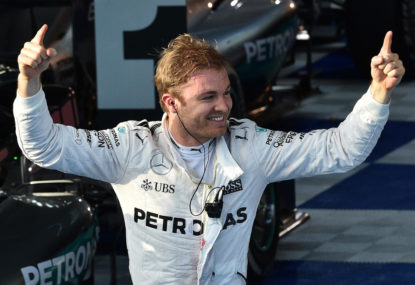No matter what you think of the cars, the tracks, or any other part of the myriad of factors that makes up modern Formula One, there’s no arguing that the opening third of Formula One 2016 has been a pleasure to watch.
From Nico Rosberg’s extended run of victories to the slashing of his championship lead from 43 points to just nine, the sport is hurtling towards its halfway point on a high.
If one were to look only at the results, however, it would be easy to mistake this season as little different from any other. Mercedes continues to share the spoils of victory among its two drivers, leaving the likes of Ferrari and Red Bull Racing to collect the scraps.
While Mercedes’s 76-point lead in the constructors championship is testament to the old phrase the stats don’t lie, the balance of the season thus far cannot be told by statistics alone.
The fact of the matter is that after two long seasons of silver-coloured domination the sport sits on the precipice of open battles for victory.
“We are coming back to normality,” said Mercedes executive director Toto Wolff “We [have been] in a lucky situation for two years to be the dominant team, and now what we are seeing is that the gaps between the top three or four teams are really shrinking.
“Ultimately this is the reason why we are all here, so my feeling is that this is pretty much the normal situation now.”
And Wolff is right, as he has been all season, to say that his team’s vice-like grip on the sport is being slackened by the latest iteration of cars from his principal rivals.
Canada, with its long back straight and slow chicanes, has been a favourite Mercedes circuit since the dawn of the hybrid turbo era in 2014, and at that season’s Canadian Grand Prix Mercedes held a 0.674-second qualifying advantage over the next fastest car, that number shrinking subtly to 0.621 seconds 12 months later.
This year the difference between Lewis Hamilton’s pole position and Sebastian Vettel’s P3 classification was 0.178 seconds, with Daniel Ricciardo’s Red Bull Racing RB12 just 0.176 seconds further back.
With such negligible difference between the top three cars, Sunday was set to be a thrilling all-in duel – and with the exception of Red Bull Racing, which struggled in the chilly Montreal weather, the sport delivered. Or, rather, it very nearly did.
Sebastian Vettel aced his start in a fashion eerily reminiscent of his getaway from the line in Melbourne, and though little was thought of the parallel at the time, it proved deeply foreboding.
With crucial track advantage over Hamilton in second – indeed, Vettel was able to manage the gap as if he had been doing so at every race since his last championship – Ferrari had the race within its grasp. But the Scuderia dropped it.
The race was finely balanced between being a one and two-stop race, with some degree of uncertainty regarding tyre degradation on the cold circuit, but Ferrari was inflexible on changing its plans for a two-stop race in light of Vettel’s hard-fought lead, ultimately undoing the team’s entire weekend.
When Vettel emerged 7.8 seconds behind Hamilton after his final pit stop, he was always going to need Hamilton to commit an uncharacteristic error to allow the Ferrari to pass the evenly matched Mercedes.
What is most galling for both Ferrari as a chief Mercedes competitor and for Formula One fans as the sport’s key stakeholders is that for the second time in a row and for the fourth time this year a leading team-driver combination has thrown away almost certain victory on an inexplicable strategy call.
In Australia, as it was in Canada, Ferrari made a tyre-strategy blunder, leaving Vettel on used supersoft tyres after the red flag period despite the Mercedes cars being switched to the medium compound.
In Spain both Red Bull Racing and Ferrari became so distracted by directing the battle between Sebastian Vettel and Daniel Ricciardo that both gave up track position around the difficult-to-pass circuit, leaving the teams’ second drivers – Max Verstappen and Kimi Räikkönen – to fight for victory.
The Monaco Grand Prix was famously marred by not one but two terminal Red Bull Racing errors. The first was to gamble Ricciardo’s crucial lead from pole position on the intermediate tyre and the second making a last-moment call to change tyre compounds for his final pit stop and losing 13 seconds to eventual winner Hamilton.
Now, for a fourth time in seven races, track position was again gambled on a marginal strategy for negligible results, and for the third time Mercedes recovered an unlikely victory.
None of this discredits Nico Rosberg’s win in Australia or Hamilton’s dual victories in Monaco and Canada, because on all three occasions Mercedes and its drivers did only what was necessary to seize the top step.
But after so many near misses, one cannot help but think that the complexion of the 2016 Formula One season could have been dramatically different if only its protagonists were more confident in the face of victory.
Follow @MichaelLamonato on Twitter





























































































